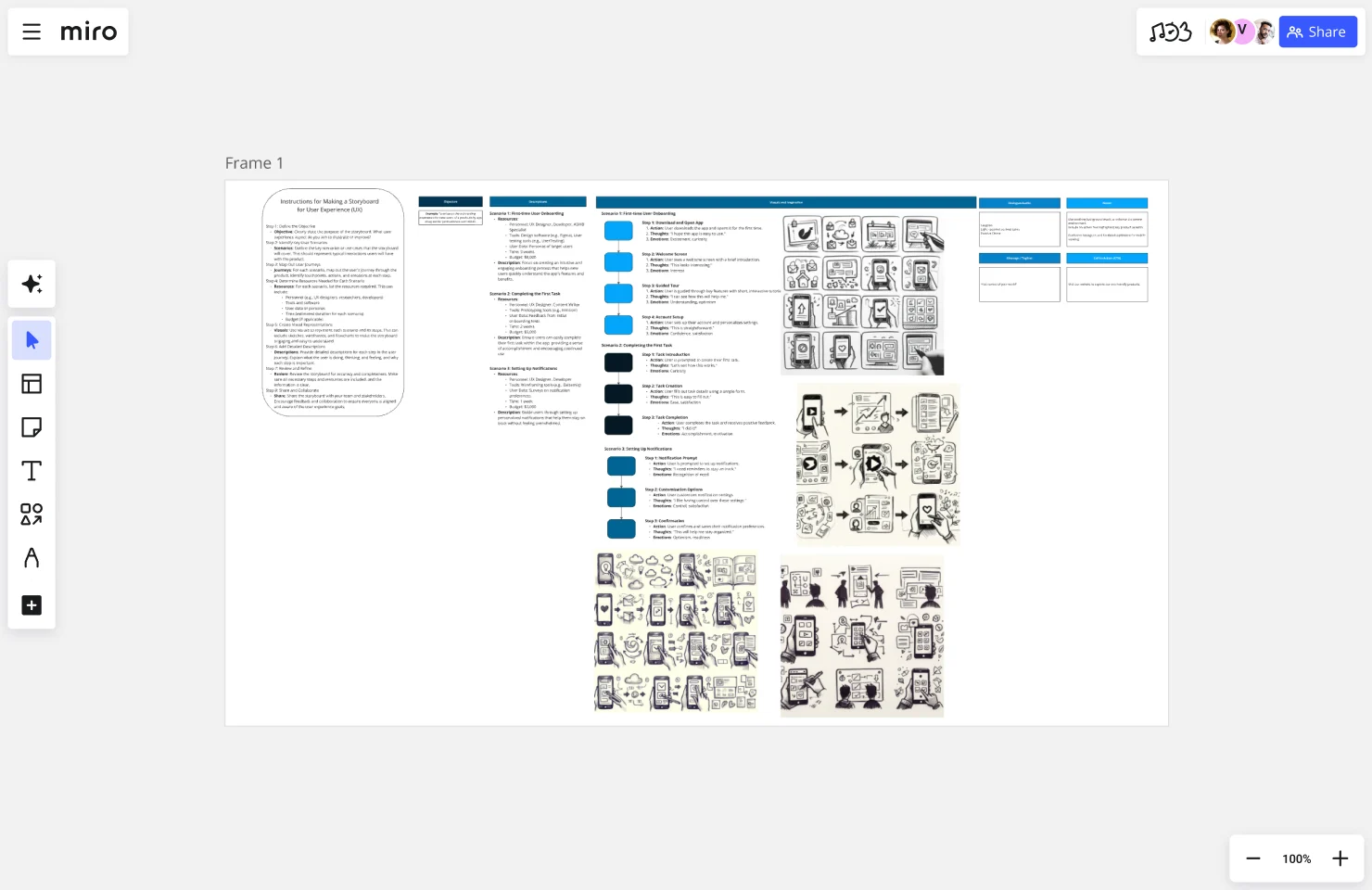Storyboard for User Experience Template
The User Experience Storyboard template helps create seamless, user-friendly journeys by visualizing interactions and identifying pain points for a more intuitive experience.
About the Storyboard for User Experience Template
Title and Objective
Title: [Project Title]
Objective: [Clearly state the purpose and goal of the user experience storyboard.]
Key User Scenarios
For each scenario, include the following sub-sections:
Scenario Name: [e.g., First-time User Onboarding, Completing the First Task, Setting Up Notifications]
Resources:
Personnel: [List the roles needed]
Tools: [List the software and tools required]
User Data: [User personas, feedback data, etc.]
Time: [Estimated duration for this scenario]
Budget: [Estimated cost for this scenario]
Description: [Detailed explanation of the scenario and its importance]
User Journeys
For each scenario, map out the user journey:
Step 1: Step Name
Action: [What the user does]
Thoughts: [What the user is thinking]
Emotions: [What the user is feeling]
Description: [Why this step is important and any additional context]
Step 2: Step Name
Action: [What the user does]
Thoughts: [What the user is thinking]
Emotions: [What the user is feeling]
Description: [Why this step is important and any additional context]
Continue for each step in the user journey.
Visual Representations
Sketches: Simple hand-drawn sketches of each step in the user journey.
Wireframes: Detailed wireframes showing the app's interface at each step.
Flowcharts: Diagrams illustrating the user’s path through the app.
Detailed Descriptions
Scenario Descriptions: In-depth descriptions for each scenario, explaining the user’s actions, thoughts, and emotions, and why each step is important.
Justifications: Reasons for choosing specific steps and how they contribute to a positive user experience.
Review and Refinement
Review Checklist: A list of items to check for accuracy and completeness.
Feedback Section: Space for team members to provide feedback and suggestions.
Sharing and Collaboration
Sharing Tools: Methods for sharing the storyboard with the team, e.g., Google Slides, Miro.
Collaboration Tools: Tools for collaborative editing and discussion.
Why Use This Template?
Structured and Organized Approach: This template provides a clear and organized way to plan and visualize the user experience, ensuring all aspects are covered comprehensively.
Enhanced Communication: Visual elements and detailed descriptions help effectively communicate user journeys and scenarios to stakeholders, team members, and other departments.
Holistic View of User Experience: By mapping out user journeys and scenarios, the template ensures that every touchpoint, action, and emotion is considered, leading to a more thorough understanding of the user experience.
Focus on User-Centered Design: Emphasizes understanding the user's thoughts, actions, and emotions, which is crucial for creating intuitive and engaging user experiences.
Encourages Collaboration: The template fosters collaboration and feedback, leading to better ideas, more refined plans, and a sense of ownership among team members.
Identification of Pain Points and Opportunities: Helps identify potential pain points and opportunities for improvement in the user journey, leading to a more seamless and enjoyable user experience.
Resource Planning: By listing the necessary resources for each scenario, it ensures that all critical aspects are considered, preventing potential issues and delays during development.
Risk Management: Clearly defined steps and resources help identify risks early and create contingency plans, reducing the likelihood of project delays and cost overruns.
Using this template can lead to a more organized, user-centered, and successful user experience design process, providing a clear roadmap from initial user interactions to refined product experiences.
This template was created by Anthony. Discover more storyboard examples and map your next project.
Get started with this template right now.
SUS Evaluation
Works best for:
Design, UX
To assess the emotional experience of users, use the SUS Evaluation Template. This involves conducting a survey with a set of questions where respondents rate their level of agreement on a scale ranging from 'Strongly Disagree' to 'Strongly Agree.' These questions evaluate various aspects of the user experience, such as ease of use, aesthetics, and overall satisfaction. This approach is valuable for comparing design iterations and evaluating the effectiveness of products and services.
Newsletter Template
Works best for:
Design, Marketing, Desk Research
Using a newsletter template allows you to create a structured and eye-catching newsletter for your subscribers. Add images, text, a call-to-action, and anything else that’ll keep your audience engaged. Take a look at Miro’s newsletter template to start creating unique and distinctive emails today.
Customer Journey Map by Hustle Badger
Works best for:
Customer Journey Map
Customer journey mapping is a method that visualizes and narrates how users navigate a site or app to achieve their objectives.
Elevator Pitch Template
Elevator Pitch Boards are concise and effective tools to showcase your idea and generate interest from stakeholders. It's an opportunity to receive valuable feedback and ensure that your proposal aligns with your target audience's needs.
Empathy Map Pro
Works best for:
Market Research, Research & Design
Empathy Map Pro helps you dive deeper into understanding your users. By exploring their thoughts, feelings, and experiences, you can create more effective solutions tailored to their needs. This advanced template is perfect for product development teams aiming to enhance user satisfaction and drive innovation.
iPhone App Template
Works best for:
UX Design, Desk Research, Wireframes
Incredible percentages of smartphone users worldwide have chosen iPhones (including some of your existing and potential customers), and those users simply love their apps. But designing and creating an iPhone app from scratch can be one seriously daunting, effort-intensive task. Not here — this template makes it easy. You’ll be able to customize designs, create interactive protocols, share with your collaborators, iterate as a team, and ultimately develop an iPhone app your customers will love.
